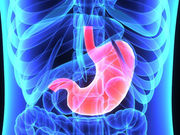Eradication rates similar in areas with high resistance to clarithromycin
FRIDAY, Aug. 19, 2016 (HealthDay News) — Both concomitant therapy and sequential therapy achieve high eradication rates as the first-line therapy for Helicobacter pylori in areas with high rates of clarithromycin resistance, according to a study published online Aug. 9 in the Journal of Gastroenterology and Hepatology.
Sung Min Park, from Incheon St. Mary’s Hospital in South Korea, and colleagues compared the efficacy and tolerability of 10- or 14-day sequential therapy (ST-10 or ST-14) with that of 10- or 14-day concomitant therapy (CT-10 or CT-14) among 341 randomly assigned H. pylori patients. The ST-10 and ST-14 groups received pantoprazole 40 mg and amoxicillin 1 g two times a day for the first five and seven days and pantoprazole 40 mg, clarithromycin 500 mg, and metronidazole 500 mg twice a day for the last five and seven days, respectively. The CT-10 and CT-14 groups received pantoprazole 40 mg, amoxicillin 1 g, clarithromycin 500 mg, and metronidazole 500 mg twice a day for 10 and 14 days, respectively.
The researchers found that the modified intention-to-treat eradication rates of ST-10, ST-14, CT-10 and CT-14 were 91.7, 91.2, 94.2, and 98.5 percent, respectively. The corresponding per-protocol eradication rates were 91.4, 91.0, 95.6, and 98.5 percent. The four groups showed no difference in compliance and adverse events. Eradication rates increased sequentially with statistical significance in the following order: ST-10, ST-14, CT-10 and CT-14 (P = 0.044).
“All four regimens achieved eradication rates >90 percent in per-protocol analyses in a country with high clarithromycin resistance,” the authors write.
Copyright © 2016 HealthDay. All rights reserved.








